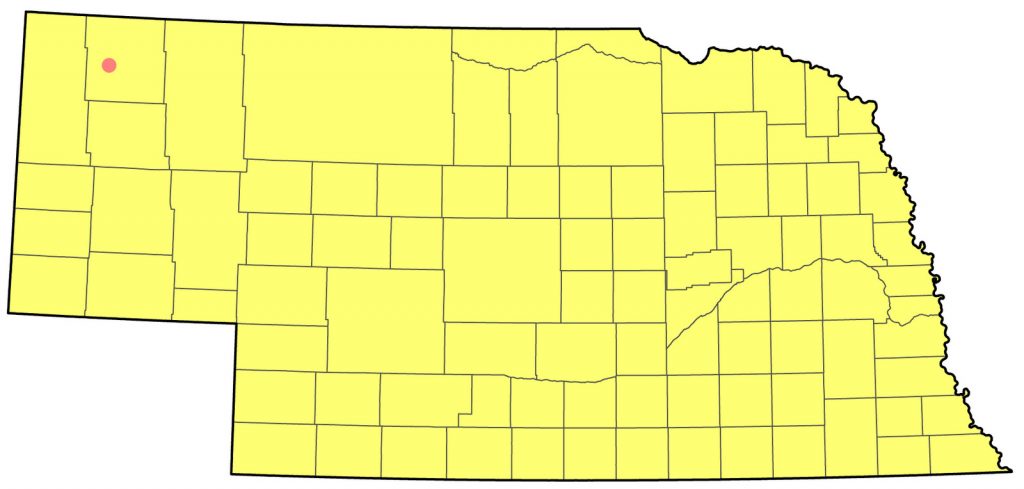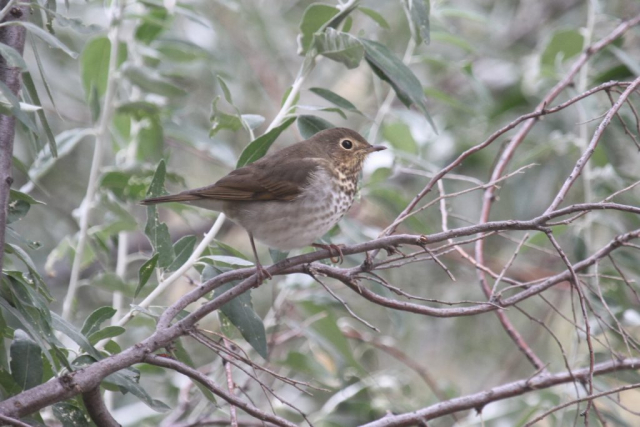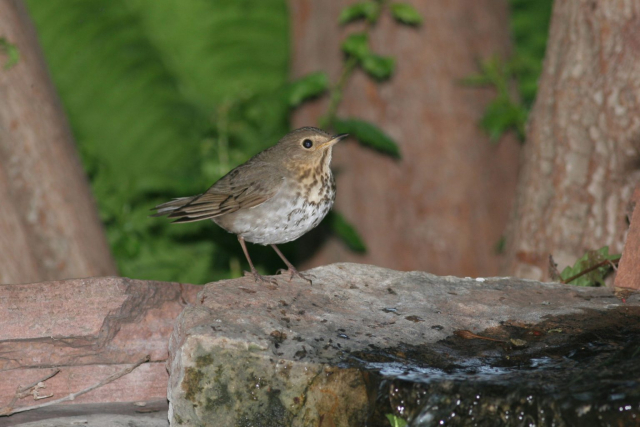Catharus ustulatus swainsoni (including C. u. almae), C. U. ustulatus
Status: Common regular spring migrant statewide. Fairly common fall migrant statewide. Rare casual breeder Pine Ridge. Accidental in winter.

Documentation: Specimens: almae (now merged with swainsonii): UNSM ZM6673, 23 May 1900 Monroe Canyon, Sioux Co; swainsoni: UNSM 11684, 8 May 1917 Lancaster Co.
Taxonomy: Six subspecies are recognized (AviList 2025), often separated into two groups, “Russet-backed” and “Olive-backed” (Mack and Yong 2020), which may prove to be sibling species (Phillips 1991). Western subspecies ustulatus, phillipsi, and oedicus comprise the Russet-backed Group, breeding along and near the Pacific coast from Alaska to Mexico, and incanus, swainsoni and appalachiensis comprise the Olive-backed Group. Among the latter group, incanus breeds coastally in northcentral and eastern Alaska and western Canada, swainsoni (including almae; see below) breeds in central and eastern Canada and northern US, and appalachiensis in the eastern US (Mack and Yong 2020).
Studies by Ruegg (2008) of an apparent hybrid zone between C. u. ustulatus and C. u. swainsoni in British Columbia suggested that the two subspecies groups may be incipient species due to a mountain crest barrier and apparent selection within the zone against hybrids. The latter may be a result of differential timing of spring migration between the two subspecies groups (Ruegg 2008). A genomic study by Delmore et al (2016) of individuals from this hybrid zone found “islands of differentiation” between the two subspecies. Nevertheless, AviList (2025) stated “Combined with relatively low morphological and vocal divergence, presence of intermediate phenotypes across a hybrid zone (Ruegg 2008), and suggestions of a hybrid swarm in Alaska, [“Russet-backed” and “Olive-backed” groups] are best treated as conspecific pending further research.”
Delmore et al (2016) found a section of Chromosome 4 in samples from the ustulatus/swainsoni hybrid zone which contained genetic material controlling migration and plumage characters, one effect among these “the decision to go south or southeast”. Introgressants from the hybrid zone tended to follow a geographically intermediate route between the two subspecies groups, suggesting that at least some, and possibly most, of the records of ustulatus in and along the eastern edge of the Rockies might in fact be introgressants, since most ustulatus migrate south in or near the Pacific Coast. and there are no fall records of ustulatus from the Rockies eastward (eBird.org, accessed Jul 2025). See Comments, below.
Virtually all of Nebraska’s migrant Swainson’s Thrushes are likely to be swainsoni, which is the most widespread of the Olive-backed Group (Phillips 1991). Putative subspecies almae has been suggested as a Pine Ridge breeder (see Summer, below). It has been suggested (Phillips 1991) that the Alaskan Olive-backed subspecies incanus may occur in Nebraska; it has been reported in northeast Illinois (AOU 1957) and migrates through at least western Oklahoma (Phillips 1991)..
It is likely that individuals of the Russet-backed Group of Pacific coast subspecies ustulatus, a Pacific Northwest breeder, or their introgressants with swainsoni, occur in Nebraska in low numbers as spring migrants (see Taxonomy). According to Mack and Yong (2020), migration routes differ between western (Russet-backed) and eastern (Olive-backed) populations; ustulatus generally following the Pacific Coast and swainsoni migrating through the central US east of the Rocky Mountains. According to eBird.org (accessed Jul 2025), there are 33 spring records of Russet-backed thrushes on the Great Plains, all along the western edge from South Dakota (one record) through western Nebraska (five records) to Colorado (27 records) and all from 5 May-1 Jun.
The five Nebraska spring records are from the southern Panhandle 13 May-1 Jun, all by Steven Mlodinow. Two photographs of an individual at Gerin Cemetery, Scotts Bluff Co are included in this checklist: 15 May 2020 – Gering Cemetery. A single (among 43 identified as swainsoni) at Oliver Reservoir, Kimball Co, 1 Jun 2019 was described as “Rusty back at first recalling Veery but not as bright. Spotting on chest more restricted than on olive-backed and not as bold. Buff face blended into rust hues of head and buff wash on chest. Sides warm brown rather than olive-gray” (1 Jun 2019 – Oliver Reservoir SRA). The other four spring records are 13 May 2024 Oliver Reservoir, 15 May 2023 Cheyenne Co, and 21 May 2022 Kimball Co.
A purported specimen of ustulatus from as far east as southeast Iowa (AOU 1957) was re-identified as a Veery (Phillips 1991). As stated by Phillips (1991) in his inimitable way, “Surely genera like Catharus are not for ornithologists less competent than Ridgway and Hellmayr, for over-eager listers, or for the shrill opponents of accuracy”.
Spring: Apr 21, 21, 22 <<<>>> Jun 3, 3, 3 (east, south), Apr 28, 28, 29 <<<>>> Jun 6, 8, 8 (north, west)
An earlier date east and south is 17 Apr 2016 Sarpy Co.
Earlier dates north and west are 21 Apr 2025 Brown Co, 23 Apr 2024 Fort Robinson SP, Dawes Co, and 26 Apr 2024 Valentine, Cherry Co.
Later dates east and south are 6 Jun 2003 Chase Co, 8 Jun 2024 Douglas Co, 19 Jun 1939 Lincoln Co (Tout 1947), 19 Jun 2008 Hamilton Co, 19 Jun 2021 recorded York Co, and 19-22 Jun 2020 Lancaster Co.
Later dates north and west are 14 Jun 2019 Scotts Bluff Co, 16 Jun 2019 Sioux Co, and 17 Jun 2006 Cherry Co.
Most pass through in May. Departure in the south and east is complete by early Jun, but a little later in the north and west.
The earliest specimen date for Kansas is 24 Apr (Thompson et al 2011); Tallman et al (2002) noted that they are “not confident” of reports earlier than the last week of Apr. Most such reports are probably of Hermit Thrushes.
- High counts: 499 in Sarpy Co 11 May 1996 (including 272 at Fontenelle Forest, Sarpy Co), 314 Night Flight Calls in Wayne Co 14 May 2021, 150 in Kimball Co 28 May 2011, 148 in the Panhandle 15 May 2002, 62 at Oliver Reservoir, Kimball Co 20 May 2024, and 58-62 there 22-23 May 2025.
High numbers often pass through the Panhandle in early Jun; best counts are 83 at Oliver Reservoir, Kimball Co 21 May 2020 and 59 there 1 Jun 2022.
Summer: The only documented breeding record is of a nest in West Ash Creek Canyon, Dawes Co 12 Aug 1973 (Rosche 1974). This nest was located in deciduous riparian growth adjacent to ponderosa pines, and contained two eggs and an “advanced fledging” nestling on 12 Aug, but the nestling was gone and the two remaining eggs were cold on 15 Aug. The eggs are now specimen UNSM ZM17073. As stated by Rosche (1974), there was no prior evidence for breeding, although it had been assumed based on Hudson’s collecting a female with enlarged ovaries 17 Jun 1938 in Squaw Canyon, Sioux Co (Hudson 1939).
Mollhoff (2001) found “several territorial males” in West Ash Canyon, Dawes Co, May, Jun, and Jul 1999, but no breeding evidence was found; no birds were there in 2000. In 2004 at least five singing males and two pairs were present 5 Jun, and a complete but empty nest was being guarded by a singing bird 8 Jun (Mollhoff 2005). In 2005 in the same area, singing birds were again present mid-Jun, but no nest was found (Mollhoff 2005). One was reported in East Ash Canyon, Dawes Co 29 Jun 2022. There are Jun and Jul reports from Sioux Co 1976-79, although no evidence of breeding was reported, as well as late Jun (but not Jul) reports for the years 1967, 1972, 1974, and 1986, and for Jul (but not Jun) in 1975. Cary (1902) and Bruner et al (1904) considered breeding to be probable in West Warbonnet Canyon based on several summer observations.
Subspecies almae was described as a Rocky Mountains breeder by Oberholser (1898), who suggested that birds reported in summer on the Pine Ridge (Cary 1902) be assigned to almae (Bruner et al 1904). This form has, however, since been merged with swainsoni (Mack and Yong 2020).
Migrants are not uncommon, however, as late as the second week of Jun in the northwest (Rosche 1982); Jun reports may also be the basis for purported nesting in the central Niobrara Valley (Bates 1900; Youngworth 1955). That these reports are likely non-breeding birds is indicated by summer reports from unlikely breeding locations 18 Jun and 27 Jul 1981 Garden Co, 22 Jun 1995 Garden Co, 23 Jun 1969 McPherson Co, 30 Jun 1967 Greeley Co, and 1-10 Jul 1989 Lincoln Co. A remarkable report was of a singing bird near Orleans, Harlan Co 6 Jul 2000 by observers familiar with the species from residence in the state of Washington; another or the same was in the same place 23 Jun 2002.
Fall: Aug 24, 25, 25 <<<>>> Oct 4, 4, 5
Earlier dates are of heard-only flyovers: 1 Aug 2024 Creighton, Knox Co, and 10 Aug 2024 Omaha, Douglas Co.
Later dates are 8 Oct 2022 Douglas Co, 10 Oct 2017 Lancaster Co, 10 Oct 2019 Douglas Co, 14 Oct 2012 Sarpy Co, 15 Oct 2017 Lancaster Co, 19 Oct 2021 Hayes Co, 26 Oct 2020 Lancaster Co, and 30 Oct 2001, a hatch year bird banded at Bellevue, Sarpy Co.
Arrival is generally in early Sep, with few records in Oct.
Numbers are far lower in fall than in spring (Mlodinow et al 2013; see Comments).
“Russet-backed Thrush” is almost unknown in fall east of the Rocky Mountains; one of the two records is for Nebraska, in Scotts Bluff Co 13 Sep 2022, described as “SWTH [Swainson’s Thrush] with bright rust upperparts and rust-buff sides. Less contrast between face and crown than OB [Olive-backed] Thrush. Prolonged look in good light with nice comparison with OB Thrush” (Mlodinow; 13 Sep 2022 – Minatare to Alice). The other fall record is, amazingly, from Ontario 9 Oct 2023, a single that lingered behind after its flock departed (eBird.org, accessed Nov 2023).
A specimen collected at Glenvil, Clay Co 3 Nov 1918 and identified as this species is no longer extant; it was likely a Hermit Thrush (Jorgensen 2012). We consider reports after mid-Oct to be of Hermit Thrushes. See Comments.
- High counts: 24 in Lincoln, Lancaster Co 13 Sep 2012, 13 at Fontenelle Forest 15 Sep 2012, 12 at Oliver Reservoir, Kimball Co 15 Sep 2023, and 11 at Wilderness Park, Lancaster Co 10 Sep 2020.
Winter: There is a single winter report, with “excellent details”, for 27 Jan-10 Feb 1980 in Washington Co (Williams 1980, Cortelyou 1980).
Comments: Far fewer Swainson’s Thrushes occur in fall than in spring. Ruegg and Smith (2002), using banding and genetic studies, proposed that the breeding range of “continental” Swainson’s Thrush (subspecies swainsoni ) shrank to a southeastern US refugium during the last glacial maximum. As the ice sheet receded, the breeding range expanded north and west. However, during fall migration, the thrushes continued to migrate southeastward to their ancestral breeding refugium, then south across the Gulf itself, thus setting up an elliptical migration pattern that largely avoids the central USA in fall. Western “coastal” Swainson’s Thrushes (subspecies ustulatus and incanus), less disrupted by ice sheets, continued to migrate along the Pacific Coast on their ancestral pathway.
Images
Abbreviations
UNSM: University of Nebraska State Museum
Literature Cited
American Ornithologists’ Union [AOU]. 1957. The AOU Check-list of North American birds, 5th ed. Port City Press, Baltimore, Maryland, USA.
AviList Core Team, 2025. AviList: The Global Avian Checklist, v2025. https://doi.org/10.2173/avilist.v2025.
Bates, J.M. 1900. Additional notes and observations on the birds of northern Nebraska. Proceedings of Nebraska Ornithologists’ Union 1: 15-18.
Bruner, L., R.H. Wolcott, and M.H. Swenk. 1904. A preliminary review of the birds of Nebraska, with synopses. Klopp and Bartlett, Omaha, Nebraska, USA.
Cary, M. 1902. Some general remarks on the distribution of life in northwest Nebraska. Proceedings of Nebraska Ornithologists’ Union 3: 63-75.
Cortelyou, R.G. 1980. 1980 (Fifty-fifth) Spring Occurrence Report. NBR 48: 70-87.
Hudson, G.E. 1939. Some ornithological results of a six-week’s collecting trip along the boundaries of Nebraska. NBR 7: 4-7.
Jorgensen, J.G. 2012. Birds of the Rainwater Basin, Nebraska. Nebraska Game and Parks Commission, Lincoln, Nebraska, USA.
Mack, D.E. and W. Yong. 2020. Swainson’s Thrush (Catharus ustulatus), version 1.0. In Birds of the World (A. F. Poole and F. B. Gill, Editors). Cornell Lab of Ornithology, Ithaca, NY, USA. https://doi.org/10.2173/bow.swathr.01.
Mlodinow, S.G., T. Leukering, and N. Pieplow. 2013. Russet-backed Thrush in Colorado. Colorado Birds 47: 135-142.
Mollhoff, W.J. 2001. 1999-2000 Nebraska nesting report. NBR 69: 92-101.
Mollhoff, W.J. 2005. The 2003-2004 Nebraska nest report. NBR 73: 15-19.
Oberholser, H.C. 1898. Description of a new North American thrush. Auk 15: 303-306.
Phillips, A.R. 1991. The known birds of North and Middle America. Part 2. Published by the author, Denver Colorado, USA.
Rosche, R.C. 1974. A Nebraska Swainson’s Thrush nest. NBR 42: 17.
Rosche, R.C. 1982. Birds of northwestern Nebraska and southwestern South Dakota, an annotated checklist. Cottonwood Press, Crawford, Nebraska, USA.
Ruegg, K. 2008. Genetic, morphological, and ecological characterization of a hybrid zone that spans a migratory divide. Evolution 62: 452–466. doi:10.1111/j.1558-5646.2007.00263.x.
Ruegg, K.C., and T.B. Smith. 2002. Not as the crow flies: A historical explanation for circuitous migration in Swainson’s thrush (Catharus ustulatus). The Proceedings of the Royal Society of London B 269: 1375–1381.
Tallman, D.A., Swanson, D.L., and J.S. Palmer. 2002. Birds of South Dakota. Midstates/Quality Quick Print, Aberdeen, South Dakota, USA.
Thompson, M.C., C.A. Ely, B. Gress, C. Otte, S.T. Patti, D. Seibel, and E.A. Young. 2011. Birds of Kansas. University Press of Kansas, Lawrence, Kansas, USA.
Tout, W. 1947. Lincoln County birds. Published by the author, North Platte, Nebraska, USA.Williams, F. 1980. Southern Great Plains Region. American Birds 34: 286-288.
Williams, F. 1980. Southern Great Plains Region. American Birds 34: 253-310.
Youngworth, W. 1955. Some birds of the Quicourt Valley. NBR 23: 29-34.
Recommended Citation
Silcock, W.R., and J.G. Jorgensen. 2025. Swainson’s Thrush (Catharus ustulatus). In Birds of Nebraska — Online. www.BirdsofNebraska.org
Birds of Nebraska – Online
Updated 28 Aug 2025


